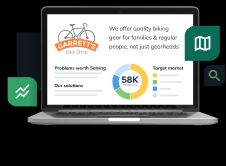
Free Download
Free Sales Forecast Template
Simplify your sales projections with this pre-built 12-month sales forecast template for product and subscription businesses.
Or start forecasting with expert support in LivePlan.
Available formats:


Downloads: 548
Why use this sales forecast template?
Fill-in-the-blanks
No need to mess with formatting or formulas; this sales forecast template is built for you to just start adding your numbers.
Completely customizable
Adjust and duplicate the forecast template to fit different timeframes if you need to look further ahead.
Built for different businesses
Our sales forecast template offers options that fit traditional unit sales as well as subscription-based business models.
Built by experts
Confidently make sales projections that you can stand by, knowing your sales forecast is powered by the small business experts here at LivePlan.
What is a sales forecast?
A sales forecast is a prediction of the sales and revenue that you believe your business will achieve over the next 3-5 years. Sales forecasts are usually done month-by-month for the first twelve months and then simplified into annual projections for the following 2-4 years.
Most companies create an initial sales forecast at the beginning of their fiscal year and then revise it on a monthly or quarterly basis.
Why sales forecasting is important
Whether you’re starting a business or have been operational for a while—putting together a solid sales forecast is one of the most important steps to set and reach your business goals.
More importantly, if you’re seeking outside investment, investors will want to know what your sales goals are and how you’re going to hit them. Projecting your sales in a way that’s easy to understand and realistic is critical for investors.
Your sales forecast will also be one of the key tools you’ll use to build your expense budget. Your sales will help determine how much you can spend and when you can spend it.
Without a sales forecast, you’ll struggle to accurately measure your profitability or determine how much money you should spend on marketing and business operations.
Frequently asked questions
A sales forecast template is a structured tool that helps businesses project future sales based on historical data, market analysis, and assumptions.
You create a sales forecast by analyzing historical data, identifying trends, factoring in market conditions, and estimating sales for future periods.
If this is your first time creating a sales forecast, start by listing possible revenue streams. Then make initial guesses for what sales will be for the first month. You can always come back and refine your projections, but for now this is the fastest and easiest way to build a sales forecast.
To create an accurate sales forecast, make sure your projections truly represent the expectations for your business.
The forecast doesn't have to be perfect, but by using reliable historical data, adjusting for seasonality, considering market conditions, and regularly updating projections—your sales forecasts will become more and more accurate.
In Sheets or Excel, input historical sales data and use formulas, such as a monthly percentage increase, to project future sales based on growth rates or trends.
You can always download a sales forecast template that includes pre-built formulas to make forecasting easier.
The best method to forecast sales is to combine historical data with industry trends and customer behavior analysis. Make adjustments for variables like seasonality and market conditions. Review your actual performance to see how accurate your previous projections were and make adjustments to future forecasts accordingly.
A company expects $50,000 in sales for the upcoming month based on a 5% increase from the prior month. This sales forecast example is driven by historical performance and expected market demand.
Try LivePlan today
Totally risk free. 35-day money-back guarantee.

